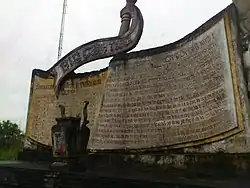| Binh Hoa Massacre | |
|---|---|
 Quảng Ngãi Province | |
| Location | Bình Hòa village, Quảng Ngãi Province, South Vietnam |
| Date | December 6, 1966 |
| Target | Bình Hòa villagers |
Attack type | Massacre |
| Deaths | 422[1]–430[2] |
| Perpetrators | South Korean forces |

The Bình Hòa Massacre, (Vietnamese: thảm sát Bình Hoà, Korean: 빈호아 학살) was a massacre purportedly conducted by South Korean forces between December 3 and December 6, 1966, of 430 unarmed civilians in Bình Hòa village, Quảng Ngãi Province in South Vietnam.[1][3] In 2000, however, it was reported that a monument within the village, gave the dates of the massacre as October 22, 24, and 26, 1966 and said that 403 people were killed by the South Koreans.[4]
The district was in the operational area of the Blue Dragon Brigade.[5] Most of the victims were children, elderly and women.[6] More than half the victims were women (including seven who were pregnant) and 166 children.[1][7] The South Korean soldiers burnt down all of the houses and killed hundreds of cows and buffalo after the atrocities.[1] A number of the survivors of the massacre joined the Viet Cong and fought against the United States and its Allies, one of which was South Korea.[1][8] South Korean forces were also accused of conducting a similar massacre in Binh Tai village within the same year.[9][10]
The massacre was discussed when British journalist Justin Wintle visited Vietnam in the late 1980s, where the report on the massacre was disclosed to Western media.[8]: 12
In popular culture
The Binh Hoa massacre was featured in a Korean documentary The Last Lullaby on the subject of Korean atrocities in South Vietnam.[11]
See also
References
- 1 2 3 4 5 "On War extra - Vietnam's massacre survivors". Al Jazeera. 2009-01-04. Archived from the original on 2015-07-01. Retrieved 2011-07-09.
- ↑ "Sở văn hóa thông tin tỉnh Quảng Ngãi". Quảng Ngãi government. Archived from the original on April 30, 2011. Retrieved 2011-07-09.
- ↑ Wintle, Justin (2006). Romancing Vietnam: inside the boat country. Signal Books Ltd. p. 266. ISBN 1-904955-15-0. Archived from the original on 2016-06-09. Retrieved 2016-10-14.
- ↑ Paul Alexander (April 9, 2000). "Villagers recall S. Korean atrocities in Viet War; Troops massacred 1,600 civilians in all, survivors say". Associated Press. Archived from the original on March 29, 2016. Retrieved March 19, 2016.
- ↑ "<8> 신화를 남긴 해병대 '짜빈동 전투' 고립된 1개 중대가 연대 규모 적 무찌르다". 국방일보. 2011-02-15. Retrieved 2012-10-14.
- ↑ "Bình Hòa Massacre". Quảng Ngãi government. Archived from the original on 2011-08-08. Retrieved 2011-07-09.
- ↑ "Korean troops' killings in Vietnam still unresolved". South China Morning Post. Archived from the original on 2018-06-12. Retrieved 2018-06-07.
- 1 2 Oliver, Kendrick (2006). The My Lai Massacre in American History and Memory. Manchester University Press. p. 11. ISBN 9780719068911.
- ↑ "Words of Condemnation and Drinks of Reconciliation Massacre in Vin Dinh Province All 380 People Turned into Dead Bodies Within an Hour". Hankyoreh. 1999-09-02. Archived from the original on 2011-07-22. Retrieved 2011-07-09.
- ↑ Armstrong, Charles (2001). Critical Asian Studies, Volume 33, Issue 4 :America's Korea, Korea's Vietnam. Routledge. p. 530.
- ↑ "Documentary on Vietnam War massacres wins honorable mention from state broadcaster". Archived from the original on 2018-06-12. Retrieved 2018-06-07.
Further reading
- Kim, Hyun Sook Lee. Korea's "Vietnam Question": War Atrocities, National Identity, and Reconciliation. Positions: East Asia Cultures Critique, Volume 9, Number 3, Winter 2001, p. 622-635. E-ISSN 1527-8271
External links
- Binh Hoa Massacre Archived 2013-09-18 at the Wayback Machine